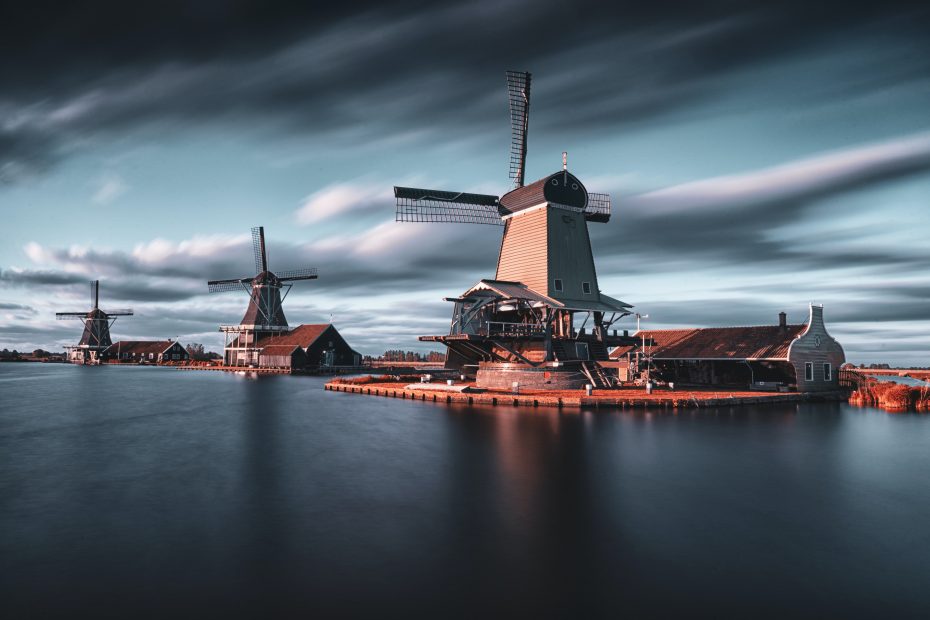Table of Contents
Introduction
The Netherlands is famous for its flat, lush green landscapes punctuated by windmills and carpeted with tulips. These two icons have come to represent the country and its culture. In this article, we’ll explore the history and significance of Dutch windmills and tulips, and some of the best places to witness these quintessential scenes.
Windmills
Windmills have been a vital part of the Netherlands’ infrastructure and identity for centuries. The earliest windmills were built as early as the 12th century to help drain water from the low-lying marshlands.
Over time, windmills were adapted for other essential tasks like milling grain, sawing wood, and pumping water. The iconic Dutch windmill with rotating sails set atop a brick tower dates back to the 16th century.
There are several types of Dutch windmills, including:
-
Smock mills – Tapered, hexagonal towers with angled roofs that can be rotated to face the wind.
-
Tower mills – Cylindrical brick towers with a rotating cap and roof.
-
Post mills – Feature a horizontal beam attached to a central post that allows the mill to turn.
Some of the best places to see historic windmills include Kinderdijk, home to 19 photogenic windmills, and Zaanse Schans with its collection of restored industrial windmills from the 18th and 19th centuries. The tallest windmill in the Netherlands is De Nolet at Schiedam which reaches over 131 ft (40 m) high.
Windmills are proudly displayed on Dutch coins, logos, and artworks. They represent the country’s centuries-old mastery of technology and reliance on renewable resources.
Tulips
Tulips are now synonymous with Dutch landscapes, but they originated as wildflowers in Central Asia. The Ottoman Empire introduced tulips to Europe in the 16th century.
Wealthy Dutch merchants started cultivating tulips, sparking a tulip mania that saw prices for rare bulbs skyrocket from the 1630s to 1650s. When the tulip market crashed, Dutch growers shifted focus to improving cultivation.
The Netherlands now produces billions of tulip bulbs annually and exports them worldwide. The Dutch landscape explodes in color from March to May when millions of tulips bloom.
Fields of vibrant red, yellow, purple, pink, orange and white tulips can be admired across the country. Top spots include Keukenhof garden, the Bollenstreek bulb region, and Aalsmeer flower auction.
The economic value and enduring beauty of tulips have made them a beloved symbol of the Netherlands for over 400 years.
Additional Notable Landscapes
Beyond windmills and tulips, there are other quintessential Dutch landscapes to explore:
-
Canals – The Netherlands has over 6,000 miles of canals used for irrigation, transport, and drainage. Canal-lined cities like Amsterdam and Leiden offer picturesque settings.
-
Dykes and polders – Massive dykes built to reclaim land from the sea and create polders (low-lying tracts of reclaimed land) have allowed the Dutch to shape their waterlogged country.
-
Cycling paths – Over 35,000 miles of dedicated cycling paths crisscross the flat Dutch countryside, past windmills, canals, and flower fields.
Conclusion
With their ever-spinning windmills and vivid tulip displays, the iconic landscapes of the Netherlands encapsulate the country’s resourcefulness and vibrant culture. Beyond these postcard-perfect scenes, the ingenious water management and idyllic cycling routes also showcase how the Dutch have mastered living in harmony with nature. From the bustling cities to the rural countryside, the landscapes of the Netherlands never cease to enchant and amaze.
FAQs
Q: When is the best time to view tulips in the Netherlands?
A: The Netherlands’ tulip season lasts from March to May, with vivid displays peaking in April.
Q: Where is the best windmill museum in the Netherlands?
A: The Dutch Windmill Museum in Arnhem has an extensive collection of windmills and exhibits on windmill technology.
Q: How many windmills are there in Holland?
A: There are around 1,000 windmills still standing in the Netherlands today.
Q: Why were windmills important in Dutch history?
A: Windmills helped drain land for agriculture and settlements. They also powered industries like timber sawing, grain processing, and pumping water.
Q: What are the most common colors of Dutch tulips?
A: Popular tulip colors include red, pink, white, yellow, orange, purple, and variations like fringed and parrot tulips.
